Villages of Iran
All the great civilizations around the world have originated from small villages with minimalist lifestyle. Throughout the history of Iran, Iranian villages have played a decisive role and have caused the continuation of life in the big cities of the country. In addition to beautiful atmosphere, Iranian villages have warm-hearted and welcoming people where there is no sign of hustle and bustle of big cities, traffic and pollution; as far as the eye can see, the greenery and freshness in front of you.
A visit to Iranian villages is always a great experience that gives you a good idea of pure Iranian culture, customs, lifestyle and the Persian Cuisine. The unique architecture, the local people from different ethnic groups, their indigenous culture and most importantly, the beautiful landscape of these villages make them a great destination for any type of visitor. Some of them have preserved their traditional styles, yet others have changed during the years and become more touristic. But still, they all are great choices for those who seek a new, authentic experience in Iran.
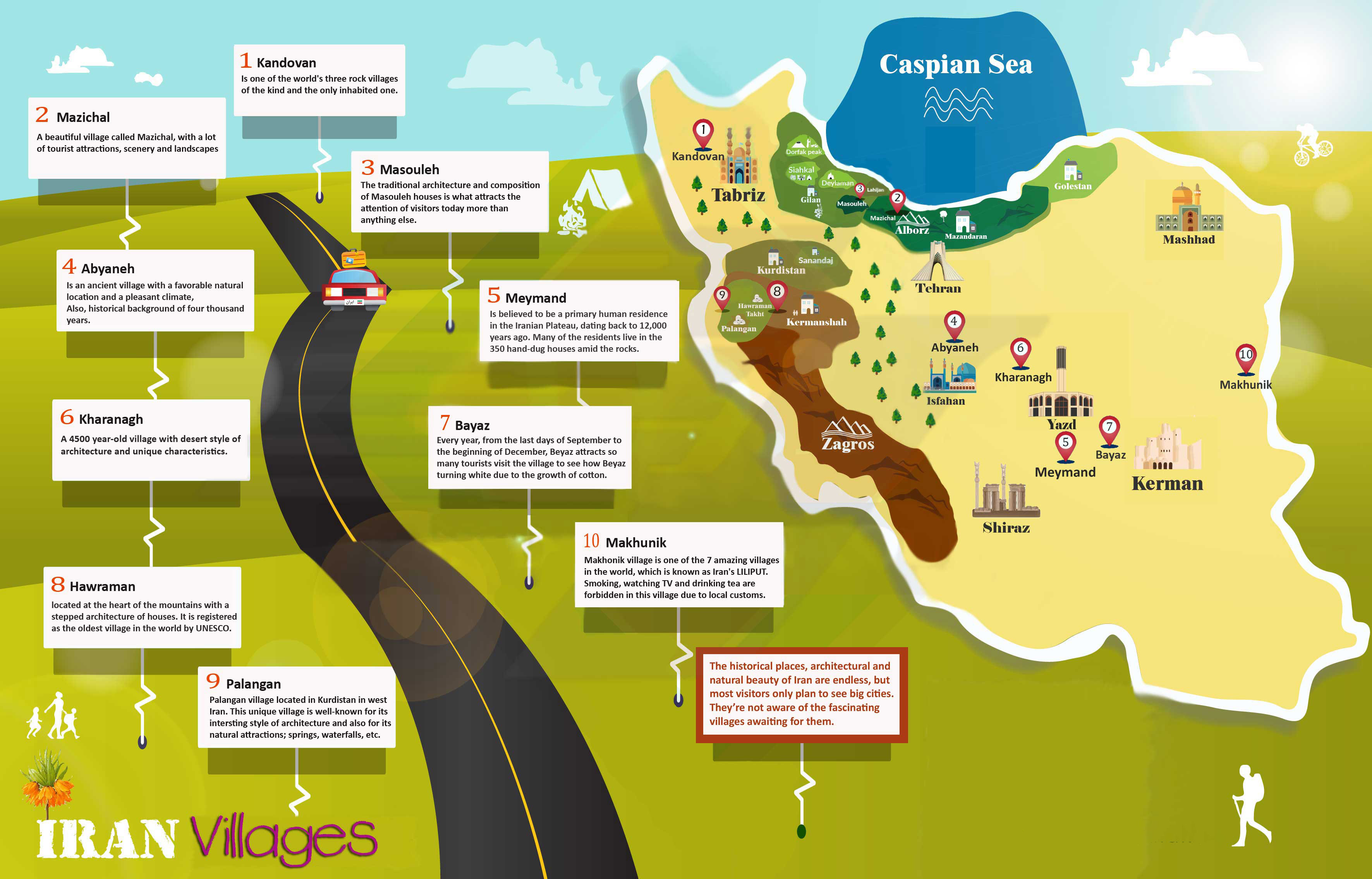
What are the most beautiful villages of Iran?
Here is a short list of the most beautiful villages in Iran:
1 Kandovan village
Kandovan is an astonishing ancient village located in East Azarbaijan province, near the city of Tabriz, Iran. With at least 800 years of historical background, this remarkable place welcomes visitors with its scenic beauty.
Inhabited by 670 people, Kandovan village is carved inside rocks and its famous rocky architecture is the main attraction of the place. The beehive-like houses (some of them 700 years old) are said to be partially formed by volcanic remains from Mount Sahand eruptions of hundreds of years ago. The inhabitants, basically, have hewn every room out of the cliff to make kitchens, halls, and bedrooms with windows decorated with colorful glasses.
Kandovan is one of the world’s three rocky villages of the kind and the only inhabited one. The architecture of Kandovan village and the current life-style of the locals in its old-fashion form is an exception in the world, since no one lives in Cappadocia (Turkey) and (United States) anymore.
Honey is one of the most important souvenirs of this village.
Kandovan is a beautiful summer region in Zagros Mountains, where lush pastures attract many Nomad tribes. Kandovan mineral water spring is also one of the attractions of this village. This water is said to have healing effects for treatment of kidney diseases.
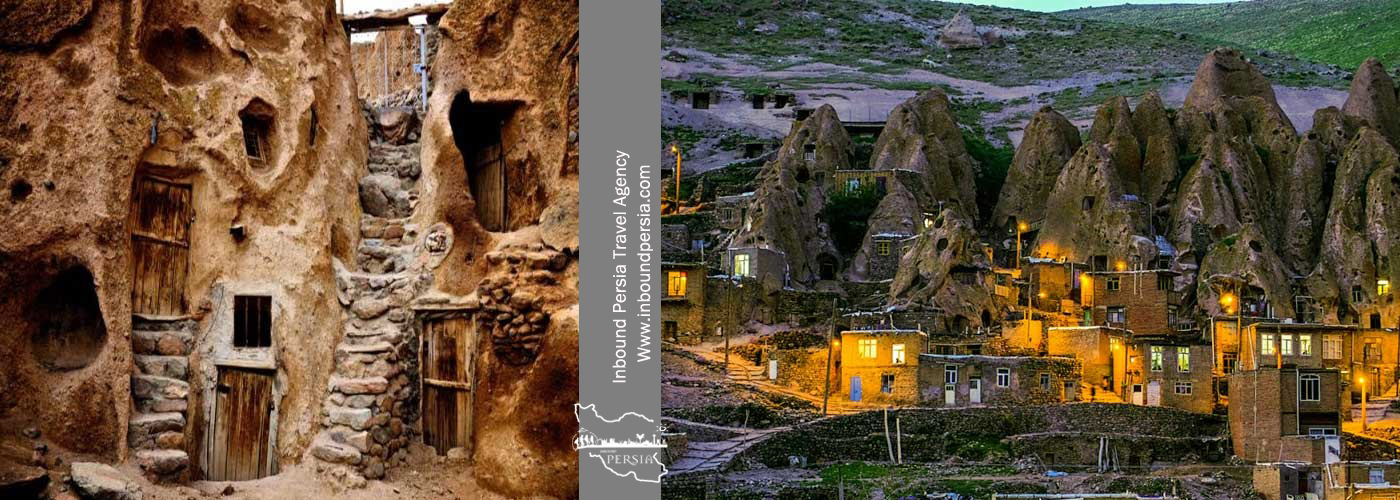
2.Mazichal village
In Kelardasht region of Mazandaran province, there is a beautiful village called Mazichal, with a lot of scenic landscapes. Mazichal as one of the most important destinations is famous for its amazing location and beauty. A summer village where virtuous and kind people live temporarily; 50 to 60 families live in this village from late June to early autumn.
The presence of dense forests and lovely white clouds that constantly change shape has made this village a special and unique travel destination. You may have heard the word “Cloud Ocean”. One of the features of Mazichal village is its view of the cloud ocean, which makes this area a wonderful pristine place.
Villagers’ summer cottages, used only by inhabitants in the summer, create a relaxing and dreamy image for visitors amidst lush greenery and blue skies.
In the spring, the growth of primrose flowers and violets leaves pleasant memories for people visiting this village.
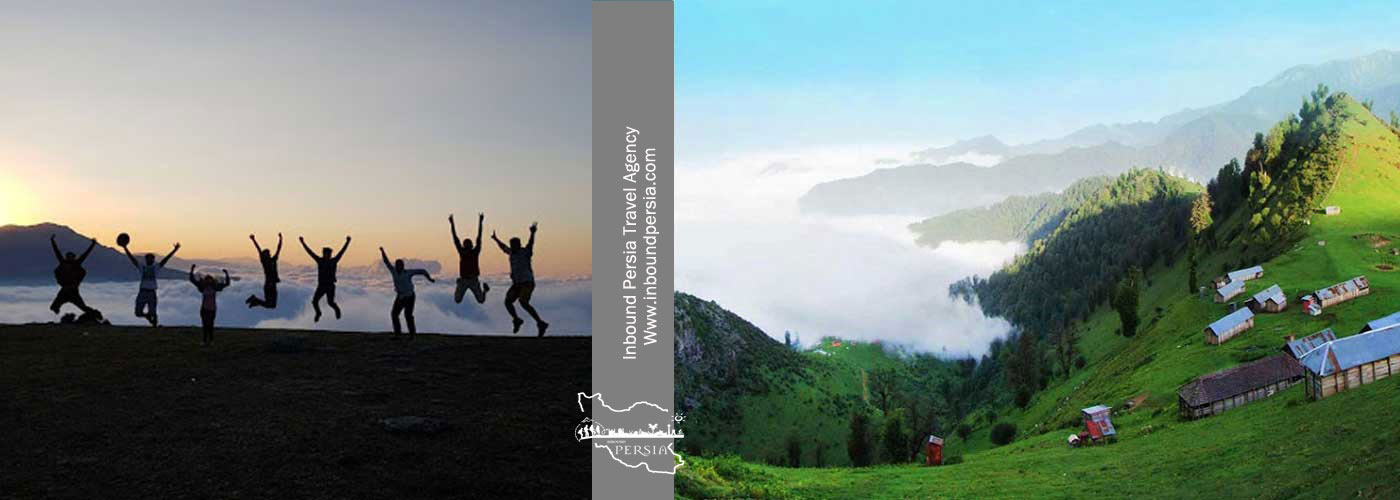
Best time to visit Mazichal
Mazichal is one of those areas where each season has its own beauties. In every season of the year, you can see a new face of this region.
In spring and summer, this area is full of special flowers and trees covered with green leaves and strange nature.
In autumn you will see a colorful picture of forest roads and finally you will reach the village of Mazichal and in the heights you can watch an ocean of white clouds along with yellow, orange and red colors.
But the best time to visit this area is the second half of spring to late summer, when the weather warms up and you can even camp there.
3.Masouleh village
Located approximately 60 km southwest of Rasht and 32 km west of Fuman, Masouleh village has been built into Alborz Mountains, 1,050 meters above sea level.
The traditional architecture and composition of Masouleh houses is what attracts the attention of visitors today more than anything else. Masouleh houses which are the main tourist attraction of this village consist of two floors: Winter floor and summer floor.
The winter part of the house is called “Sumeh” in the local dialect. At the back of this section there is a small room with a stove in the middle, which is used for cooking and preparing food, also for providing heat. There are niches around the room where cooking dishes are placed; as well as decorative porcelain and copper dishes.
The summer part of the house or the so-called counter room has wooden and upholstered windows. These windows have porcelain knots with geometrical patterns and are decorated with beautiful and colored glasses.
In addition to the counters in some houses, there is a room constructed on top of the roof, which is called “Burj” meaning tower. Burj is used for some summer activities.
The architecture of present Masouleh was formed During “Zandieh” period(18th C); The roofs of each house on lower tiers is used as a courtyard for another house on the tiers above them. In some cases, public streets are laid out along interconnected roofs. The land in front of the house doors and the roofs of each house are both used as sidewalks. Narrow streets and numerous stairs don’t allow motor vehicles to pass.
Masouleh traditional food is also one of the tourist attractions of this village:
One of the traditional dishes of Masouleh is called Mirza Ghasemi. Mirza Ghasemi is one of the delicious dishes cooked in North Iran. Origination of this dish goes back to 1860 AD, named after its innovator, Qasim Khan Vali, the governor of Rasht.
Masouleh souvenirs is another tourist attraction of the this village:
Products such as Kilim (needle-work rug made of goat’s hair), Jajim (a primitive type of persian carpet made of wool or cotton), shawls and socks, wood and metal products, local clothes and sweets, small dolls woven with yarn, gloves and other hand-made souvenirs are some of the items sold at the bazaar of Masouleh.
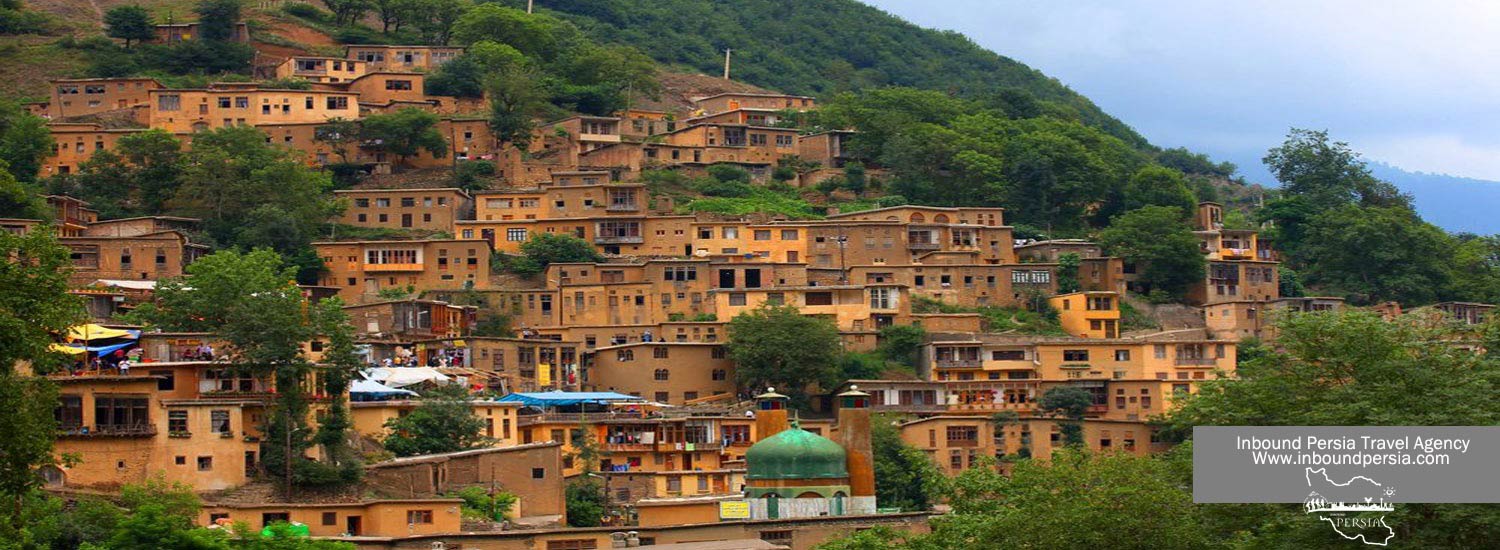
4.Abyaneh village
Located 87 km from the city of Kashan, Abyaneh is one of the most scenic village attractions in Iran which will definitely amaze you if you visit it.”Abyaneh” is an ancient village with a pleasant climate that has a favorable natural location and a historical background of four thousand years. During the Safavid era, when Safavid kings went to Natanz for summer, many of their relatives and courtiers preferred to stay in this village. In the local language, Abyaneh is called “Viuna”. “Vi” means willow tree and “Viuna” means a willow grove; Over time, “Viuna” changed to “Avianeh” and then to Abyaneh.
Traditional unique architecture of Abyaneh is the most popular tourist attraction of this place. Most houses are built in the shape of a cube with wooden lattice doors and windows. The houses are stacked on top of each other which are seen in mountainous areas as the outstanding property of this village. The old buildings of the village are covered with red soil. Due to an unusual high level of iron oxide, the soil in Abyaneh village has a reddish, beautiful color which makes it even more distinguished
This ancient Abyaneh has highly preserved its language, architecture, costume, culture, and traditional rituals over the centuries.
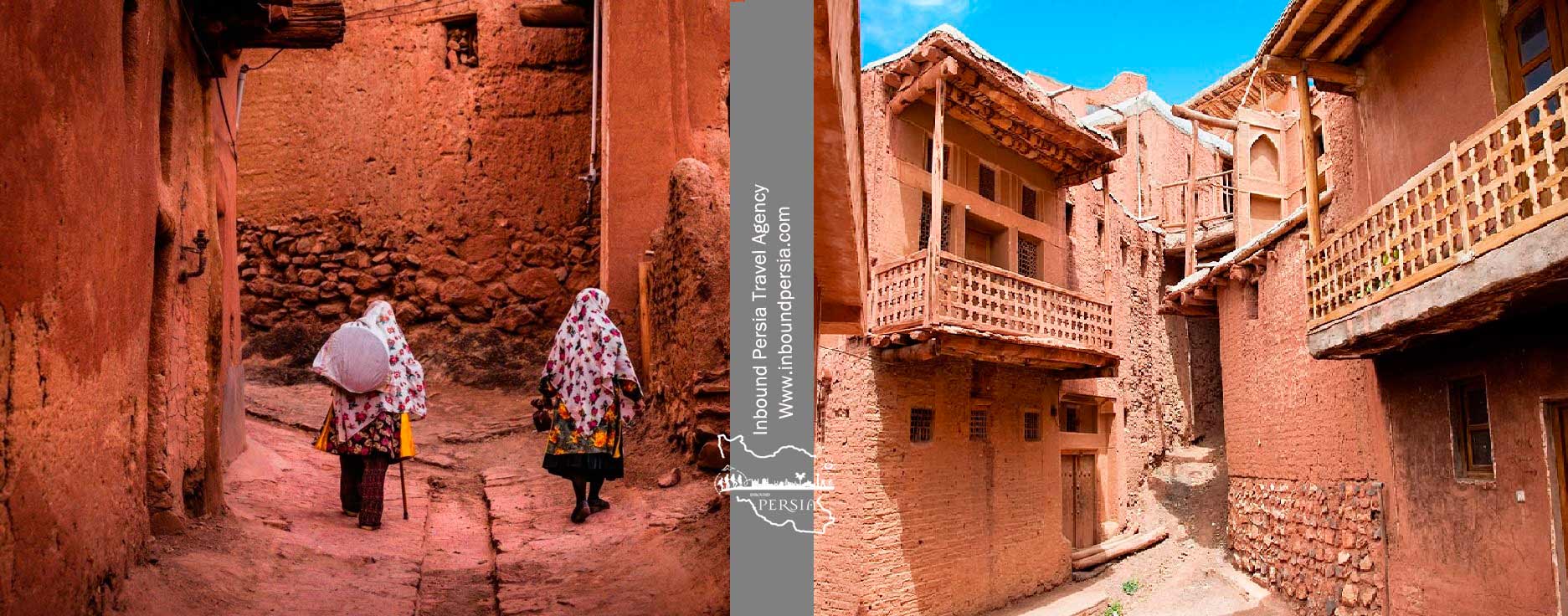
5.Meymand village
In every province of Iran, there are villages that attract visitors from all over the world due to their prominent features. Kerman province is no exception to this rule and has introduced one of its amazing villages to the world.
Meymand village is located in Kerman province, 38 km away from Shahr Babak city, at an altitude of 2240 meters above sea level. The area of the village is about 420 km. This village is also known as rocky village due to the presence of many rocks in its mountains that have been dug by inhabitants.
The name Meymand consists of two words Mey (wine) and Mand (drunk). The villagers tell different stories for this naming. According to heart-to-heart stories, the villagers began digging holes in the rock after drinking and getting drunk. But some people believe that Meymand is Meymanat meaning happiness.
The main feature of Meymand, is the structure and shape of the houses. No mortar was used in the construction of these houses. They have dug houses in the heart of the mountains and rocks, without the need for soil, water, bricks and mortar.
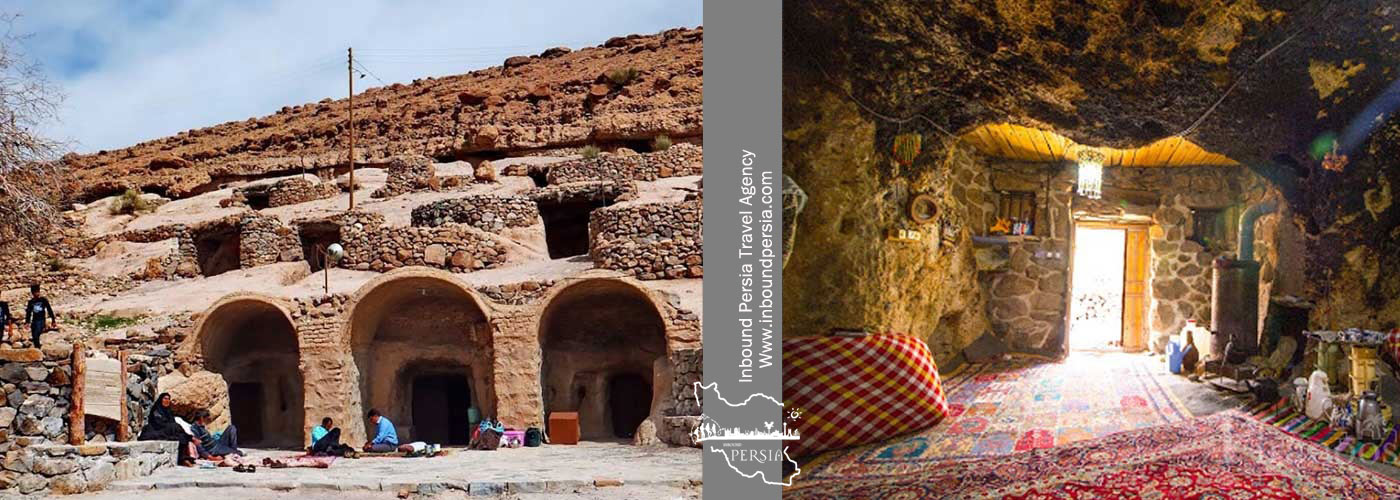
In each room, a niche has been dug to place various items on it. In this type of architecture, the houses are called kicheh consisting of one or two rooms and one stable. Each house has a common entrance to which the rooms are connected. The shape and structure of the kichehs are different and their size is also different. Room temperatures are always about five degrees warmer than outside temperatures. The stoves are inside the rooms, and the color of the ceilings and walls of the rooms has turned black due to the burning of firewood in the stoves. It is interesting to know that the presence of fire and food preparation in the room has caused insulation and this has increased the life-time of the rooms. Roofs of the rooms where fire has not been lit for several years have been ruined. The largest kiche in Meymand is about ninety square-meters and most rooms have an area of about 12 square-meters.
In the lifestyle of the people is another tourist attraction of Meymand because the interaction between man and nature is still established and ancient traditions have been preserved. Also, the occupation of the people of Meymand village is agriculture and livestock.
6.Kharanagh village
80 km from the city of Yazd, the ancient village of Kharanagh or Khoranagh , with an approximate age of 4500 years and a historical background of 1800 years, is one of the important heritages of Iranian history. The oldest existing historical document, in which this region is mentioned, dates back to 1370 years ago during the reign of Yazdgerd III, the last king of the Sasanian Empire. This document is in fact a report of a Zoroastrian cleric and shows the prosperity of Kharanagh as a resting place and it’s caravanserai made for merchants and travelers. The old name “Khor-anagh” means the birthplace of the sun.
Kharanagh village consists of two parts, old and new. The old part, also known as Kharanagh Castle, has been uninhabited for about three decades and its old and spectacular buildings are very spectacular. In this section you will see structures that are 1800 years old. The new section is also home to simple, minimalist villagers who live on planting crops such as turmeric, melons, cotton, wheat and barley. 145 families live in the village of Kharanaq in Yazd. This village is also of great economic importance for the country due to it’s Iron ore, Uranium, Barite, Zinc and Granite mines. Many animals live in the heart of this desert , including cheetahs, rams, goats, wild cats, rabbits and foxes, and birds such as terns, partridges and ravens.
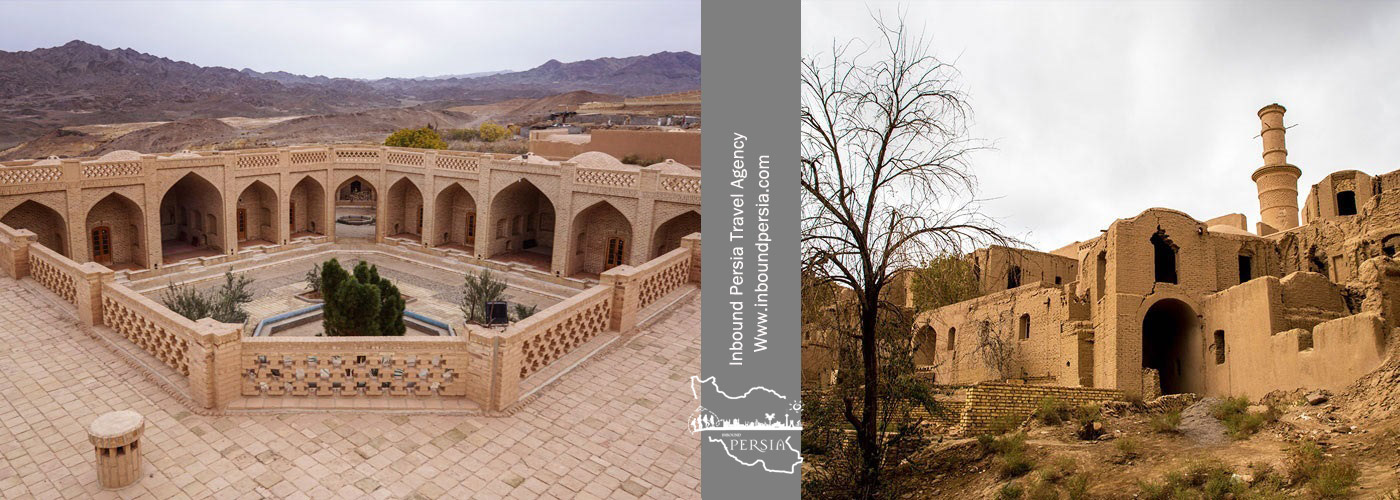
Citadel of Kharanagh
The beautiful 1800 year-old castle is located in the old part of Kharanagh village. This citadel and its fortress belong to the Sassanid period. Made entirely of clay and mud, Kharanagh castle was about one hectare in area and served as a residential citadel. The space inside the castle is completely secure and its houses are often two or three storeied. The castle has 6 watch towers and it’s internal alleys are so narrow and winding. These alleys are some of the interesting parts of this castle, behind which a historical story is hidden. The villagers used these narrow passages to surprise thieves and bandits. One of the most famous one was called “Wolf Alley” where bandits were usually trapped in this labyrinthine alley until the guards be prepared to arm up and ambush them.
Kharanaq historical caravanserai has been renovated and you can make the best travel experience for yourself by staying in the heart of the desert. If you stay in this village at night, you can also watch the starry desert sky.
7.Bayaz village
Every year, from the last days of September to the beginning of December, Bayaz attracts so many tourists visiting the village to see how Bayaz turning white due to the season of socalled white gold feilds (cotton). Calling cotton “white gold” should not come as a surprise; This agricultural product has such an economic value that it is no less important than gold. Bayaz village is a place for planting and harvesting such precious gold. Therefore, one of the first cotton processing factories in Iran was built in Bayaz, and this small village plays a valuable role in the country’s economy.
Bayaz village has a population of slightly less than four thousand people. This village owes its valuable position not only to the cotton fields but also to its ancient history. Apart from the cotton fields, historical monuments such as Persian Qanats, the old mills, Abbasi Caravanserai, Sabz Pooshan Mosque, Twin Water reservoir and Bayaz Castle are what make Bayaz a tourist attraction destination.
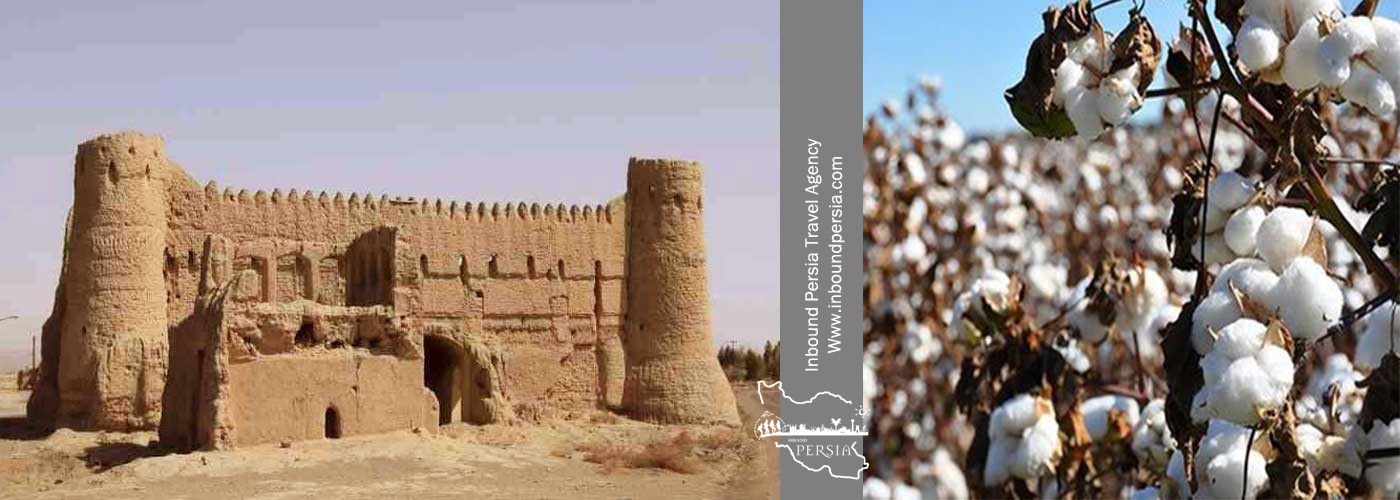
Bayaz castle
It is the most significant work that can be seen at the entrance of this village. This castle has been used as a defensive fortification of the village. There are now 5 towers left of this two-story castle. Some of the foundations and columns of this castle are still intact, although the exact age of this building is still unknown.
The village of Bayaz had long been on a caravan route through which merchants transferred their most valuable commodity, tea and spices, from India. The caravan route of India was called the “Royal Road” and the village of Bayaz was one of the well-known refreshment spots on the road, due to its Caravanserai. Bayaz Shah Abbasi caravanserai dates back to 400 years ago. It is said that its architect left his work unfinished when he heard about the death of Shah Abbas. The total area of the caravanserai is more than two thousand meters.
Bayaz twin reservoir is also spectacular. This reservoir has two tanks, large and small, and each tank has a wind tower.
8.Hawraman village (Uraman Takht)
Hawraman or Uraman Takht is a village in Sarvabad county in Kurdistan province of Iran. The village of Hawraman in Kurdistan is registered as
Hawraman located in the heart of the mountains has a stepped architecture of houses (for this reason it is also known as “Hezar Masouleh”), the stones are stacked on top of each other and the houses are made without mortar. The roofs of each house is the courtyard of another house, which are called “Heyvan” in the local language. At the foot of the mountain, the houses are carved in harmony with nature. Such a balance is less common in the architecture of villages.
“Pir-e-Shaliar” ceremony is very famous in this city.

9.Palangan village
Palangan village is one of the most spectacular villages in Kurdistan province. Palangan with its amazing stepped architecture and beautiful nature has been registered in the cultural heritage list of Iran and has been titled “Lost Paradise” and also “Masouleh of Kurdistan”.
In this village, there are is no sign of modern buildings, but as far as you can see, there are multi-story houses as the roof of one house is the yard of another.
Local food is another tourist attraction of Palangan village:
Before entering Palangan and also along the river, you will see booths of trout fish. Here, you can order great grilled fish, served with thin local loaves of bread.
Doogh, Shalmin, Parpuleh, Volosheh, Ghazineh and a variety of vegetarian dishes are also the most common local dishes in Palangan village.
Palangani inhabitants are engaged in agriculture, livestock, handicrafts and fisheries. In the west part of this village, you can see orchards, which are one of the sights of Palangan. Wheat, barley, fruits such as pomegranate, peach, apricot, fig and dairy products such as buttermilk and curd are the most important products of this village and of course fresh fish and natural honey that you can buy from the locals during a trip to Palangan.
Do not forget to buy the handicrafts as the most tourist attraction of Palangan village:
The beautiful and special handicrafts of this village are manufactured by the skilled women of Palangan. Wedge weaving, jajim weaving and wave weaving are the most famouse handicrafts of Palangan.
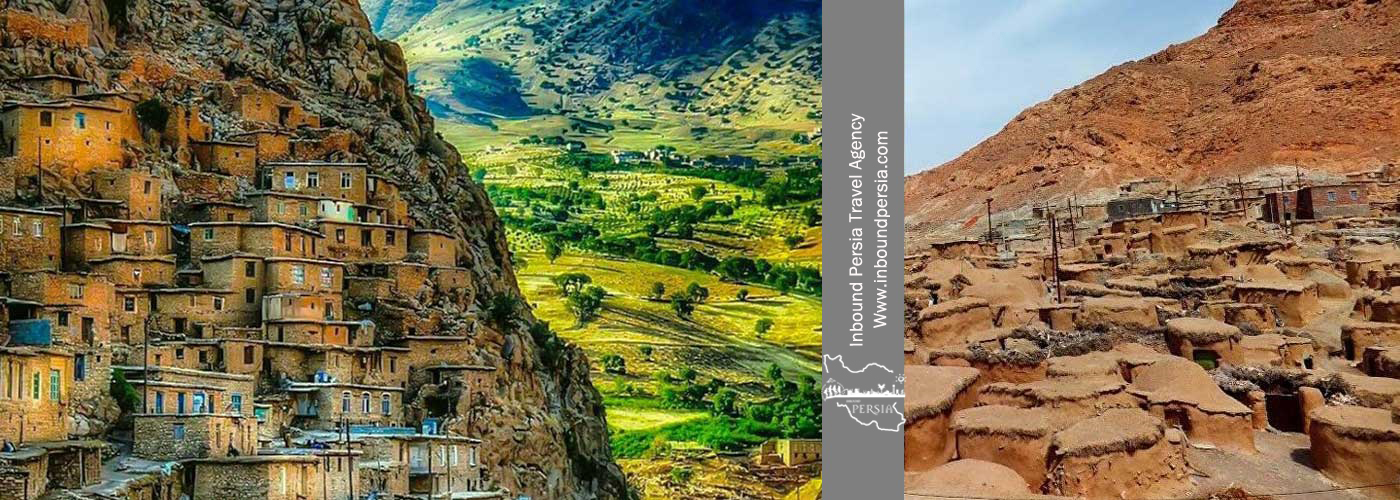
10.Makhunik village
Due to it’s amazing charms in terms of its reputation as the city of the Lilliputians, the village of Makhunik is one of the most amazing villages in the world. It is half an hour from the border of Afghanistan and actually Makhunik locals are originally Afghans who migrated from Afghanistan a few centuries ago and chose this place to live. This village is located 78 km east of Sarbisheh city in South Khorasan province and on the road from Sarbisheh to Doroh village.
Makhunik village is known as one of the seven amazing villages of the world due to its architecture, customs and special culture of its people. Makhunik is a village nestled in barren mountains in a remote area where you can live for centuries out of sight.
In the past, the village was semi-isolated and had no driving access to the outside world, but in recent years, a part of the mountain has been dug to build a road for the village to access easily. The most important feature of Makhunik village is the old texture, in which modest adobe houses have been built without any courtyards, porches, windows, and decorations.
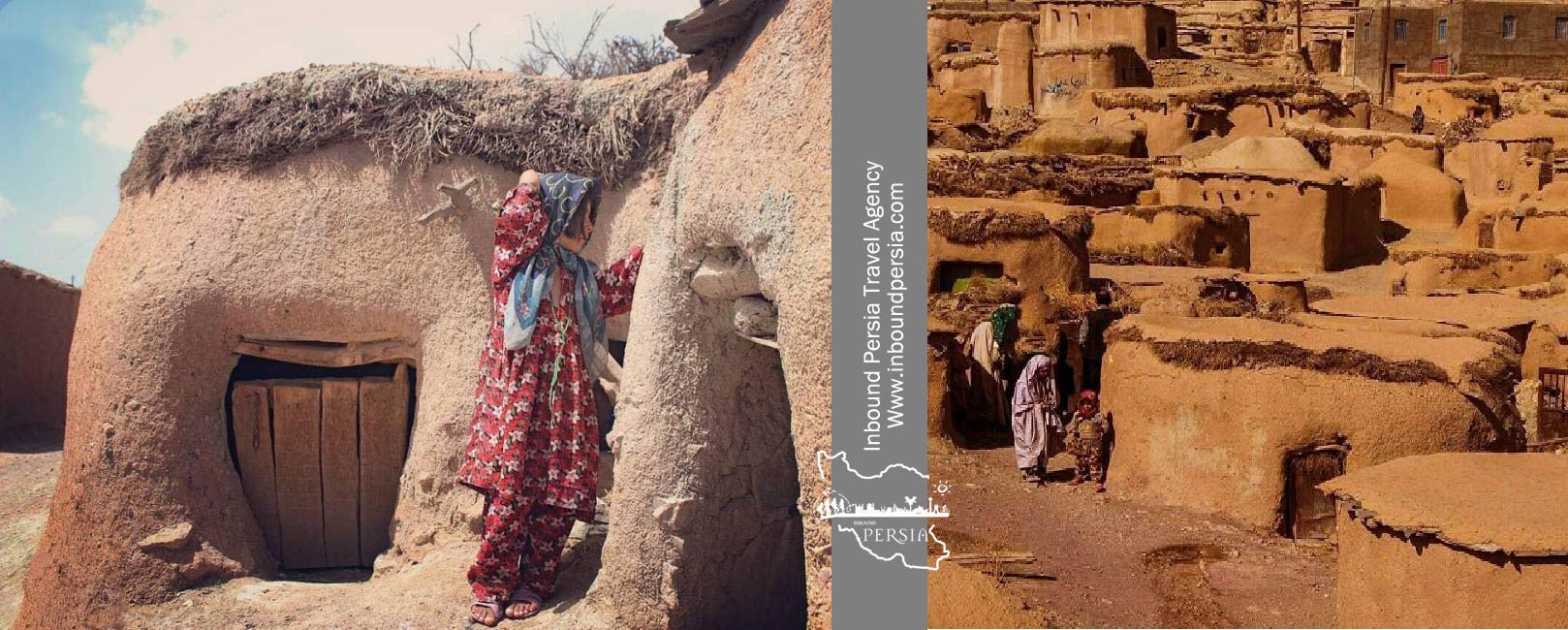
With a variety of scheduled and customized tours and travel services across Iran, operated by a professional tour operator (Inbound Persia Travel Agency) with offices in Iran and Italy and Uzbekistan we try our best to organize and prepare the best tours across Iran.
Iran is deeply surprising with amazing culture, history, civilization and nature. Iran tours don't fit into any easy pigeonhole. Join our tour packages and become more familiar with Iran and Iran tours.